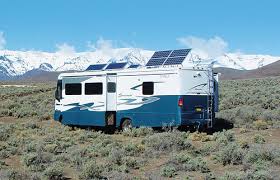
Once you hook up to a power source you are able to have the comforts of home by turning on and off the lights and using the bathroom. If you cannot access a power outlet you may use a generator to supply power to the camper. These generators are nice in a pinch but you have the problems of running out of fuel to keep it going not to mention the noise that it makes. If you want to turn your RV into a solar power RV it is simple to do and with little expense. There are a number of different products that you can buy to make camping fun and modern with little or no effort.
You can mount a solar panel to the RV camper in order to charge your energy in your RV. This is done by purchasing a solar panel mounting bracket that your solar panel will set on. You can buy RV solar panel kits that include both the mount and the panel. Once it is installed you can power your camper and batteries using the suns warmth that was already there and it doesn't cost you an arm and a leg to do so. Run your solar panel wire to the battery compartment and you are ready to go. Each solar powered kit offers different wattages and sizes so you can select the right one for your RV size and what you will be using.
When you are out on a camping trip you can feel good knowing that you can go anywhere you need to go. Your solar panel on top of your RV will also withstand any type of weather and because a camper is so small it won't take much solar power to operate the RV. Another hot solar powered item to buy for your RV is called the Solar Power Ventilator. This provides the perfect ventilation system for small quarters, such as RV's. When it is hot in the summer or anytime that the sun is shining it doesn't take long for the RV to heat up and become very uncomfortable. The solar power ventilator will run all the hot air out and circulate the air with clean fresh air.
When you take the RV out you want to enjoy your time in the great outdoors without giving up the fact that you have to rely on a power source or go without power completely. If you have to go without power you may find that it is inconvenient and hard to do, especially when you purchase an RV because of the way that it is convenient.




